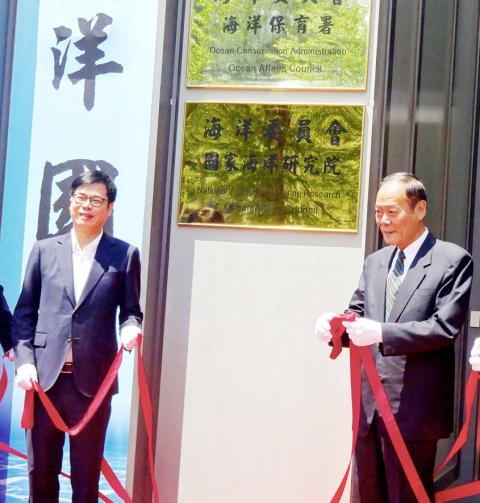Vice Premier Chen Chi-mai (陳其邁) yesterday inaugurated the National Academy of Marine Research in Kaohsiung, saying that it would boost the nation’s international participation in ocean affairs.
Establishment of the academy, which is overseen by the Ocean Affairs Council (OAC), comes almost a year after the council was established on April 28 last year.
The academy is tasked with planning ocean-related policy, assembling research and developing marine industries, Chen said.

Photo: CNA
It is also expected to boost connections between the nation and the global community by increasing participation at conferences and organizations, he said, adding that he hopes it would lead Taiwan to become a safe and prosperous maritime nation.
Academy Acting Director-General Chiu Yung-fang (邱永芳), a professor in National Sun Yat-sen University’s department of marine environment and engineering, accepted the agency’s seal from OAC Minister Lee Chung-wei (李仲威).
The Executive Yuan has authorized the academy to hire 80 officials, but it has only recruited 15, academy spokesperson Lin Shih-chang (林世昌) said.
The academy’s focus this year includes drafting a sea area management bill for areas beyond 3 nautical miles (5.4km) of the nation’s coastline, as well as conducting research on ocean current energy generation and marine geology in waters off the southeastern coast, Lin said.
The academy said in a press release that it also plans to build a fleet of ocean research vessels, which might mean its mission could overlap with the Taiwan Ocean Research Institute of the National Applied Research Laboratories.
The academy would seek to collaborate with the institute, as the latter has more research resources, Lin said.
Decisions on building vessels would be determined by higher authorities, he said.
It would be better for the nation to have different agencies managing official and non-official research vessels, an academic said on condition of anonymity.
A vessel’s basic information, including whether it is government-owned, can be viewed on the global Automatic Identification System, while its identity would influence its activity in territorial waters of foreign nations, the academic said.

US climber Alex Honnold is to attempt to scale Taipei 101 without a rope and harness in a live Netflix special on Jan. 24, the streaming platform announced on Wednesday. Accounting for the time difference, the two-hour broadcast of Honnold’s climb, called Skyscraper Live, is to air on Jan. 23 in the US, Netflix said in a statement. Honnold, 40, was the first person ever to free solo climb the 900m El Capitan rock formation in Yosemite National Park — a feat that was recorded and later made into the 2018 documentary film Free Solo. Netflix previewed Skyscraper Live in October, after videos

Starting on Jan. 1, YouBike riders must have insurance to use the service, and a six-month trial of NT$5 coupons under certain conditions would be implemented to balance bike shortages, a joint statement from transportation departments across Taipei, New Taipei City and Taoyuan announced yesterday. The rental bike system operator said that coupons would be offered to riders to rent bikes from full stations, for riders who take out an electric-assisted bike from a full station, and for riders who return a bike to an empty station. All riders with YouBike accounts are automatically eligible for the program, and each membership account

NUMBERS IMBALANCE: More than 4 million Taiwanese have visited China this year, while only about half a million Chinese have visited here Beijing has yet to respond to Taiwan’s requests for negotiation over matters related to the recovery of cross-strait tourism, the Tourism Administration said yesterday. Taiwan’s tourism authority issued the statement after Chinese-language daily the China Times reported yesterday that the government’s policy of banning group tours to China does not stop Taiwanese from visiting the country. As of October, more than 4.2 million had traveled to China this year, exceeding last year. Beijing estimated the number of Taiwanese tourists in China could reach 4.5 million this year. By contrast, only 500,000 Chinese tourists are expected in Taiwan, the report said. The report

Temperatures are forecast to drop steadily as a continental cold air mass moves across Taiwan, with some areas also likely to see heavy rainfall, the Central Weather Administration (CWA) said. From today through early tomorrow, a cold air mass would keep temperatures low across central and northern Taiwan, and the eastern half of Taiwan proper, with isolated brief showers forecast along Keelung’s north coast, Taipei and New Taipei City’s mountainous areas and eastern Taiwan, it said. Lows of 11°C to 15°C are forecast in central and northern Taiwan, Yilan County, and the outlying Kinmen and Lienchiang (Matsu) counties, and 14°C to 17°C